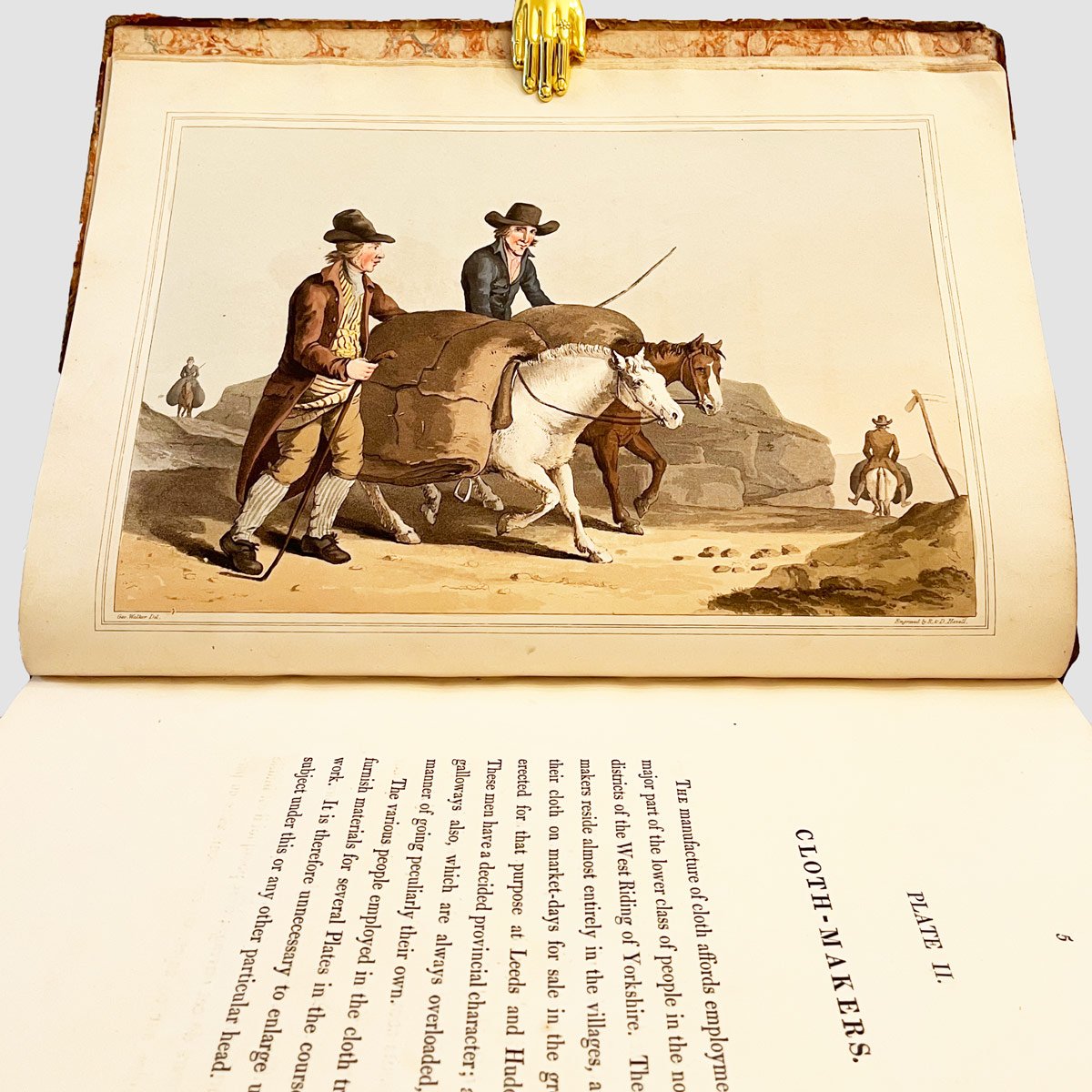 Image 1 of 6
Image 1 of 6

 Image 2 of 6
Image 2 of 6

 Image 3 of 6
Image 3 of 6

 Image 4 of 6
Image 4 of 6

 Image 5 of 6
Image 5 of 6

 Image 6 of 6
Image 6 of 6







(WALKER, George.) The Costume of Yorkshire, illustrated by a series of forty engravings, being fac-similes of original drawings, with descriptions in English and French.
First Edition. Small folio (37*26.5cm), bound in half calf, re-backed with original spine laid down, hand-coloured aquatint frontispiece and 40 plates by R. and D.Havell after George Walker, text in English and French, 96 pp. Printed by T. Bensley, Bolt Court, Fleet Street, London for Longman, Hurst, Rees, Orme, and Brown, Paternoster Row; Ackermann, Strand; and Robinson, Son and Holdsworth, Leeds. 1814.
Some wear to the binding, light spotting to the front and rear blanks, else a fine example.
The illustrations in this work are an important historical record as they have become iconic depictions of the English working classes. The illustrations associated with the production of textiles at the start of the industrial age are particularly notable. Some of the subjects covered in this work include: local trades such as farmers, factory children and jockies.
Plate III “The Collier” is famous as it depicts in the background the first representation of a steam-engine on rails. In the image, the steam-engine is hauling coal at the Middleton colliery. This steam locomotive was designed and built in 1812 by Murray & Blenkinsop in Leeds , about two years before Stephenson’s engine. By 1815, Blenkinsop had built four engines of this type for the colliery, which could haul 90 tons of coal.
(Abbey Life 432; Colas 3044; Tooley 498.)
Please contact us for shipping costs if ordering from outside the UK.
First Edition. Small folio (37*26.5cm), bound in half calf, re-backed with original spine laid down, hand-coloured aquatint frontispiece and 40 plates by R. and D.Havell after George Walker, text in English and French, 96 pp. Printed by T. Bensley, Bolt Court, Fleet Street, London for Longman, Hurst, Rees, Orme, and Brown, Paternoster Row; Ackermann, Strand; and Robinson, Son and Holdsworth, Leeds. 1814.
Some wear to the binding, light spotting to the front and rear blanks, else a fine example.
The illustrations in this work are an important historical record as they have become iconic depictions of the English working classes. The illustrations associated with the production of textiles at the start of the industrial age are particularly notable. Some of the subjects covered in this work include: local trades such as farmers, factory children and jockies.
Plate III “The Collier” is famous as it depicts in the background the first representation of a steam-engine on rails. In the image, the steam-engine is hauling coal at the Middleton colliery. This steam locomotive was designed and built in 1812 by Murray & Blenkinsop in Leeds , about two years before Stephenson’s engine. By 1815, Blenkinsop had built four engines of this type for the colliery, which could haul 90 tons of coal.
(Abbey Life 432; Colas 3044; Tooley 498.)
Please contact us for shipping costs if ordering from outside the UK.
First Edition. Small folio (37*26.5cm), bound in half calf, re-backed with original spine laid down, hand-coloured aquatint frontispiece and 40 plates by R. and D.Havell after George Walker, text in English and French, 96 pp. Printed by T. Bensley, Bolt Court, Fleet Street, London for Longman, Hurst, Rees, Orme, and Brown, Paternoster Row; Ackermann, Strand; and Robinson, Son and Holdsworth, Leeds. 1814.
Some wear to the binding, light spotting to the front and rear blanks, else a fine example.
The illustrations in this work are an important historical record as they have become iconic depictions of the English working classes. The illustrations associated with the production of textiles at the start of the industrial age are particularly notable. Some of the subjects covered in this work include: local trades such as farmers, factory children and jockies.
Plate III “The Collier” is famous as it depicts in the background the first representation of a steam-engine on rails. In the image, the steam-engine is hauling coal at the Middleton colliery. This steam locomotive was designed and built in 1812 by Murray & Blenkinsop in Leeds , about two years before Stephenson’s engine. By 1815, Blenkinsop had built four engines of this type for the colliery, which could haul 90 tons of coal.
(Abbey Life 432; Colas 3044; Tooley 498.)
Please contact us for shipping costs if ordering from outside the UK.
